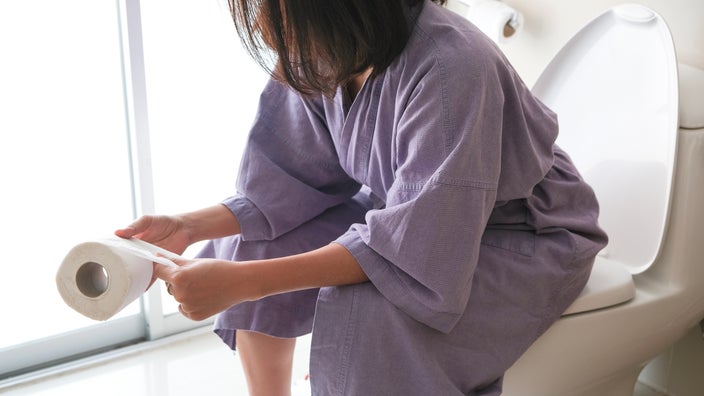
Hemorrhoid Creams: Uses, How to Apply, and Other Hemorrhoid Treatments
Key takeaways:
Hemorrhoid creams can help with many symptoms of hemorrhoids like itching, burning, pain, and swelling. Other options like ointments are available as well.
There are over-the-counter (OTC) and prescription hemorrhoid creams available. A healthcare professional can help you find the right one to use.
Besides hemorrhoid creams, your healthcare professional may recommend fiber, sitz baths, or surgery.

Hemorrhoid cream is a medication you probably hope you’ll never need. But hemorrhoids are more common than you might think. In fact, everyone has hemorrhoids. You just may not notice them until they cause you a problem — like when they become swollen or inflamed. Each year, over 1 million U.S. adults have inflamed or swollen hemorrhoids. Thankfully, there are various treatments available, and medicated hemorrhoid creams can be a helpful option.
For most people, hemorrhoids aren’t serious enough to require a visit to a healthcare professional. Most often, you can manage hemorrhoids at home. Remedies include lifestyle changes and over-the-counter (OTC) treatments like hemorrhoid cream. But using hemorrhoid creams and products for the first time can be intimidating.
Let’s take a closer look at hemorrhoid creams and products — including what they are and how to use them.
Search and compare options
What does hemorrhoid cream do?
Hemorrhoid cream is a product that you apply on the outside or inside of your anal area. The cream helps with symptoms of hemorrhoids like swelling, pain, and itching. Surprisingly, there’s not much data that shows hemorrhoid creams are effective. But they’re still commonly used.
There’s a few different ingredients that you can find in hemorrhoid creams. These ingredients target different hemorrhoid symptoms. And they each work in different ways. OTC and prescription hemorrhoid creams often combine two or more of the following ingredients:
Steroids: Hemorrhoid creams with steroids like hydrocortisone (Anusol-HC) reduce inflammation, redness, and itching.
Protectants: Some ingredients — like mineral oil and petrolatum — can protect the skin and irritated areas. These hemorrhoid ointments prevent dryness and can soothe the affected area.
Decongestants: Rectal phenylephrine can shrink blood vessels, which can relieve burning and swelling caused by hemorrhoids.
Local anesthetics: Numbing creams have local anesthetics to relieve pain and soreness. These are only for external use and shouldn’t be used inside the rectum without the direction of a healthcare professional. Pramoxine (Proctofoam HC), lidocaine (Ana-Lex), or benzocaine can be used.
Astringents: These products protect irritated areas and can relieve discomfort and burning. Examples include witch hazel.
Talk to your primary care provider or other healthcare professional about which hemorrhoid cream is best for you. They can help you choose a product with ingredients that will target your symptoms.
Types of hemorrhoid creams and products
There are a few types of medicated creams or ointments available to help with hemorrhoids. Many of these can be found OTC, but some are only available with a prescription. There’s one major difference between prescription and OTC hemorrhoid creams: Prescription hemorrhoid creams are stronger. This means they have a higher concentration of active ingredients.
OTC hemorrhoid creams and products
OTC hemorrhoid products are widely available and affordable. They can help treat symptoms of mild hemorrhoids. There are many different branded and generic products available for hemorrhoid treatment. The table below lists some common OTC hemorrhoid products and their active ingredients.
Active ingredients | Examples of OTC products |
Benzocaine | |
Witch hazel | |
Witch hazel, phenylephrine | |
Mineral oil, petrolatum, phenylephrine | |
Hydrocortisone |
Prescription hemorrhoid cream
There are a few types of prescription-only hemorrhoid products available. Stronger prescription hydrocortisone products come in many forms. These include in suppositories (like Anusol-AC or Protocort) and creams (like Proctocream HC). Other prescription steroid products may combine hydrocortisone and lidocaine (like Ana-Lex). These products may help with hemorrhoids that aren’t relieved by OTC hydrocortisone treatments.
For a thrombosed hemorrhoid (a blood clot inside of an external hemorrhoid), the most common complaint is anal pain. Nitroglycerin ointment (Rectiv) and/or nifedipine ointment have been used to treat this pain. But these aren’t FDA-approved for hemorrhoid treatment.
Both nitroglycerin ointment and nifedipine ointment can also be used to treat pain caused by anal fissures (small tears in the lining of the anus). Nifedipine ointment is not commercially available. So, if you’re given a prescription for this medication, a compounding pharmacy has to make it.
How to apply hemorrhoid cream
Each hemorrhoid cream comes with instructions for how to apply the cream to the rectal area. Many creams come with an applicator for easier application. It’s most effective to apply hemorrhoid cream just after a bowel movement. This will ensure the medication can stay where it needs to.
Here are some steps you can follow for how to apply hemorrhoid cream:
Wash your hands and the affected anal area with a gentle soap and warm water.
Dry the anal area gently by patting or blotting with toilet tissue or a soft cloth.
Apply a thin layer of cream to the affected area.
If treating internal hemorrhoids (inside the anus), you will likely need to use an applicator.
To use the applicator, first lubricate the applicator tip by spreading the cream around it.
Gently insert the applicator into the anus and apply the cream directly to the hemorrhoids.
What else can you do for hemorrhoids?
While hemorrhoid cream can be helpful for treating hemorrhoids, other treatments can also work. Let’s take a closer look at other ways to manage hemorrhoid symptoms.
Fiber supplementation
Getting enough fiber has been shown to improve symptoms of hemorrhoids like bleeding. This is because fiber helps create soft bulky stools that can be passed without straining. You should strongly consider adding fiber-rich foods to your diet, no matter what else you do for hemorrhoids.
If you can’t get enough fiber in your diet, OTC supplements like psyllium (Metamucil) can help you get enough fiber. The recommended daily intake of fiber is about 25 g for women and 38 g for men.
Sitz baths
A sitz bath is a warm, shallow bath taken up to 3 times a day for about 20 minutes at a time. It’s often recommended to help soothe pain from hemorrhoids. But a review of studies found no benefit for hemorrhoids. So while sitz baths are likely safe, there’s no guarantee they’ll be helpful.
Surgery
Depending on the type and severity of your hemorrhoids, surgery may be your best option. For small internal hemorrhoids, rubber band ligation is a common option. During this procedure, the hemorrhoids are tied off with a small rubber band. This procedure can usually be performed in the office. But this option can’t be used on hemorrhoids that are too large or external.
Another surgical option is a hemorrhoidectomy. During this procedure, one or more of your hemorrhoids will be cut out. This surgery occurs in the operating room and requires some form of anesthesia. A hemorrhoidectomy tends to cause more postoperative pain. But it’s also linked to a lower chance of hemorrhoid recurrence.
The bottom line
Topical hemorrhoid products can treat hemorrhoid symptoms such as burning, itching, and pain. OTC products for the treatment of hemorrhoids often include more than one ingredient. This may include steroids and local anesthetics.
Prescription hemorrhoid treatments include stronger medications if OTC options don't work. Surgery may be recommended if your hemorrhoids are more severe. Your healthcare professional can help you select a hemorrhoid product that can help target your most bothersome symptoms.
Why trust our experts?



References
Albuquerque, A. (2016). Rubber band ligation of hemorrhoids: A guide for complications. World Journal of Gastrointestinal Surgery.
Alonso-Coello, P., et al. (2006). Fiber for the treatment of hemorrhoids complications: A systematic review and meta-analysis. The American Journal of Gastroenterology.
Blistex Inc. (2021). Tucks Medicated Cooling Pads- witch hazel solution [package insert].
Dolgencorp, LLC. (2021). DG health hemorrhoidal- mineral oil, petrolatum, phenylephrine hcl ointment [package insert]. DailyMed.
Haleon US Holdings LLC. (2024). Preparation H Cooling Gel- phenylephrine hcl, witch hazel gel [package insert].
Haleon US Holdings LLC. (2024). Preparation H Soothing Relief Anti-Itch- hydrocortisone cream [package insert].
Haleon US Holdings LLC. (2024). Preparation H- mineral oil, petrolatum, phenylephrine hcl ointment [package insert].
Insight Pharmaceuticals LLC. (2020). Americaine- benzocaine ointment [package insert].
Katsinelos, P., et al. (2006). Aggressive treatment of acute anal fissure with 0.5% nifedipine ointment prevents its evolution to chronicity. World Journal of Gastroenterology.
Mott, T., et al. (2018). Hemorrhoids: Diagnosis and treatment options. American Family Physician.
National Institute of Diabetes and Digestive and Kidney Diseases. (2017). Treatment of hemorrhoids.
Pray, W. S., et al. (2011). Counseling patients with hemorrhoids. U.S. Pharmacist.
Richards, E., et al. (2021). Phenylephrine. StatPearls.
Schubert, M. C., et al. (2009). What every gastroenterologist needs to know about common anorectal disorders. World Journal of Gastroenterology.
Shanmugam, V., et al. (2005). Rubber band ligation versus excisional haemorrhoidectomy for hemorrhoids. Cochrane Database of Systematic Reviews.
Tejirian, T., et al. (2005). Sitz bath: Where is the evidence? Scientific basis of a common practice. Diseases of the Colon & Rectum.
Zuber, T. J. (2002). Hemorrhoidectomy for thrombosed external hemorrhoids. American Family Physician.



















